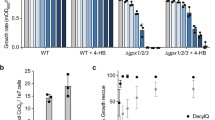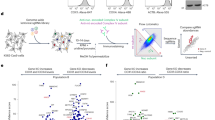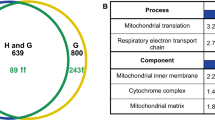Abstract
The novel yeast protein Tar1p is encoded on the anti-sense strand of the multi-copy nuclear 25S rRNA gene, localizes to mitochondria, and partially suppresses the mitochondrial RNA polymerase mutant, rpo41-R129D. However, the function of Tar1p in mitochondria and how its expression is regulated are currently unknown. Here we report that Tar1p is subject to glucose repression and is up-regulated during post-diauxic shift in glucose medium and in glycerol medium, conditions requiring elevated mitochondrial respiration. However, Tar1p expression is down-regulated in response to mitochondrial dysfunction caused by the rpo41-R129D mutation or in strains lacking respiration. Furthermore, in contrast to the previously reported beneficial effects of moderate over-expression of Tar1p in the rpo41-R129D strain, higher-level over-expression exacerbates the ROS-derived phenotypes of this mutant, including decreased respiration and life span. Finally, two-hybrid screening and in vitro-binding studies revealed a physical interaction between Tar1p and Coq5p, an enzyme involved in synthesizing the mitochondrial electron carrier and antioxidant, coenzyme Q. We propose that Tar1p expression is induced under respiratory conditions to maintain oxidative phosphorylation capacity, but that its levels in mitochondria are typically low and stringently controlled. Furthermore, we speculate that Tar1p is down-regulated when respiration is defective to prevent deleterious ROS-dependent consequences of mitochondrial dysfunction.





Similar content being viewed by others
References
Baba SW, Belogrudov GI, Lee JC, Lee PT, Strahan J, Shepherd JN, Clarke CF (2004) Yeast Coq5 C-methyltransferase is required for stability of other polypeptides involved in coenzyme Q biosynthesis. J Biol Chem 279:10052–10059
Barkovich RJ, Shtanko A, Shepherd JA, Lee PT, Myles DC, Tzagoloff A, Clarke CF (1997) Characterization of the COQ5 gene from Saccharomyces cerevisiae. Evidence for a C-methyltransferase in ubiquinone biosynthesis. J Biol Chem 272:9182–9188
Bonawitz ND, Shadel GS (2007) Rethinking the mitochondrial theory of aging: the role of mitochondrial gene expression in lifespan determination. Cell Cycle 6:1574–1578
Bonawitz ND, Clayton DA, Shadel GS (2006a) Initiation and beyond: multiple functions of the human mitochondrial transcription machinery. Mol Cell 24:813–825
Bonawitz ND, Rodeheffer MS, Shadel GS (2006b) Defective mitochondrial gene expression results in reactive oxygen species-mediated inhibition of respiration and reduction of yeast life span. Mol Cell Biol 26:4818–4829
Bonawitz ND, Chatenay-Lapointe M, Pan Y, Shadel GS (2007) Reduced TOR signaling extends chronological life span via increased respiration and upregulation of mitochondrial gene expression. Cell Metab 5:265–277
Burke D, Dawson D, Steerns T (2000) Methods in yeast genetics. A Cold Springs Harbor Laboratory course manual. Cold Spring Harbor Press, Cold Spring Harbor, p 205
Coelho PS, Bryan AC, Kumar A, Shadel GS, Snyder M (2002) A novel mitochondrial protein, Tar1p, is encoded on the antisense strand of the nuclear 25S rDNA. Genes Dev 16:2755–2760
DeRisi JL, Iyer VR, Brown PO (1997) Exploring the metabolic and genetic control of gene expression on a genomic scale. Science 278:680–686
Gasch AP, Spellman PT, Kao CM, Carmel-Harel O, Eisen MB, Storz G, Botstein D, Brown PO (2000) Genomic expression programs in the response of yeast cells to environmental changes. Mol Biol Cell 11:4241–4257
Hagerman RA, Willis RA (2002) The yeast gene COQ5 is differentially regulated by Mig1p, Rtg3p and Hap2p. Biochim Biophys Acta 1578:51–58
Hagerman RA, Trotter PJ, Willis RA (2002) The regulation of COQ5 gene expression by energy source. Free Radic Res 36:485–490
Hoffman CS, Winston F (1987) A ten-minute DNA preparation from yeast efficiently releases autonomous plasmids for transformation of Escherichia coli. Gene 57:267–272
James AM, Smith RA, Murphy MP (2004) Antioxidant and prooxidant properties of mitochondrial Coenzyme Q. Arch Biochem Biophys 423:47–56
Johnston M, Carlson M (1991) Regulation of carbon and phosphate utilization. Cold Springs Harbor Press, Plainview
Kelly DP, Scarpulla RC (2004) Transcriptional regulatory circuits controlling mitochondrial biogenesis and function. Genes Dev 18:357–368
Kermekchiev M, Ivanova L (2001) Ribin, a protein encoded by a message complementary to rRNA, modulates ribosomal transcription and cell proliferation. Mol Cell Biol 21:8255–8263
Kief DR, Warner JR (1981) Coordinate control of syntheses of ribosomal ribonucleic acid and ribosomal proteins during nutritional shift-up in Saccharomyces cerevisiae. Mol Cell Biol 1:1007–1015
Kumar A, Harrison PM, Cheung KH, Lan N, Echols N, Bertone P, Miller P, Gerstein MB, Snyder M (2002) An integrated approach for finding overlooked genes in yeast. Nat Biotechnol 20:58–63
Lahaye A, Stahl H, Thines-Sempoux D, Foury F (1991) PIF1: a DNA helicase in yeast mitochondria. Embo J 10:997–1007
Lecrenier N, Foury F (1995) Overexpression of the RNR1 gene rescues Saccharomyces cerevisiae mutants in the mitochondrial DNA polymerase-encoding MIP1 gene. Mol Gen Genet 249:1–7
Lin SJ, Kaeberlein M, Andalis AA, Sturtz LA, Defossez PA, Culotta VC, Fink GR, Guarente L (2002) Calorie restriction extends Saccharomyces cerevisiae lifespan by increasing respiration. Nature 418:344–348
Liu Z, Butow RA (2006) Mitochondrial retrograde signaling. Annu Rev Genet 40:159–185
Manthey GM, Przybyla-Zawislak BD, McEwen JE (1998) The Saccharomyces cerevisiae Pet309 protein is embedded in the mitochondrial inner membrane. Eur J Biochem 255:156–161
Petes TD, Botstein D (1977) Simple Mendelian inheritance of the reiterated ribosomal DNA of yeast. Proc Natl Acad Sci USA 74:5091–5095
Pon L, Schatz G (1991) Biogenesis of yeast mitochondria, 1st edn. Cold Springs Harbor Press, Plainview
Rodeheffer MS, Boone BE, Bryan AC, Shadel GS (2001) Nam1p, a protein involved in RNA processing and translation, is coupled to transcription through an interaction with yeast mitochondrial RNA polymerase. J Biol Chem 276:8616–8622
Rodriguez-Aguilera JC, Gavilan A, Asencio C, Navas P (2005) The role of ubiquinone in Caenorhabditis elegans longevity. Ageing Res Rev 4:41–53
Ross-Macdonald P, Sheehan A, Roeder GS, Snyder M (1997) A multipurpose transposon system for analyzing protein production, localization, and function in Saccharomyces cerevisiae. Proc Natl Acad Sci USA 94:190–195
Rusche LN, Kirchmaier AL, Rine J (2003) The establishment, inheritance, and function of silenced chromatin in Saccharomyces cerevisiae. Annu Rev Biochem 72:481–516
Saraste M (1999) Oxidative phosphorylation at the fin de siecle. Science 283:1488–1493
Schuller HJ (2003) Transcriptional control of nonfermentative metabolism in the yeast Saccharomyces cerevisiae. Curr Genet 43:139–160
Shadel GS (1999) Yeast as a model for human mtDNA replication. Am J Hum Genet 65:1230–1237
Sherman F (2002) Getting started with yeast. Methods Enzymol 350:3–41
Sinclair DA, Guarente L (1997) Extrachromosomal rDNA circles—a cause of aging in yeast. Cell 91:1033–1042
Tran UC, Clarke CF (2007) Endogenous synthesis of coenzyme Q in eukaryotes. Mitochondrion 7(Suppl):S62–S71
Wallace DC (2005) A mitochondrial paradigm of metabolic and degenerative diseases, aging, and cancer: a dawn for evolutionary medicine. Annu Rev Genet 39:359–407
Warner JR (1989) Synthesis of ribosomes in Saccharomyces cerevisiae. Microbiol Rev 53:256–271
Warner JR (1999) The economics of ribosome biosynthesis in yeast. Trends Biochem Sci 24:437–440
Yaffe MP, Schatz G (1984) Two nuclear mutations that block mitochondrial protein import in yeast. Proc Natl Acad Sci USA 81:4819–4823
Zelenaya-Troitskaya O, Newman SM, Okamoto K, Perlman PS, Butow RA (1998) Functions of the high mobility group protein, Abf2p, in mitochondrial DNA segregationrecombination and copy number in Saccharomyces cerevisiae. Genetics 148:1763–1776
Acknowledgments
This work was supported by grant DAAD19-00-1-0650 from the Army Research Office. M.C-L. was supported by NIH Training grant GM07499-30. C.M.W. was a visiting student from the University of Bath when this work was performed. We wish to thank Dr. Michael Snyder for providing the Tar1p::LacZ reporter strain and the anti-Tar1p peptide antibody, Dr. Catherine Clarke for the Coq5p antibody, and Dr. William Studier for the bacterial Coq5p expression plasmid used in this study.
Author information
Authors and Affiliations
Corresponding author
Additional information
Communicated by R. Jensen.
Rights and permissions
About this article
Cite this article
Bonawitz, N.D., Chatenay-Lapointe, M., Wearn, C.M. et al. Expression of the rDNA-encoded mitochondrial protein Tar1p is stringently controlled and responds differentially to mitochondrial respiratory demand and dysfunction. Curr Genet 54, 83–94 (2008). https://doi.org/10.1007/s00294-008-0203-0
Received:
Revised:
Accepted:
Published:
Issue Date:
DOI: https://doi.org/10.1007/s00294-008-0203-0




